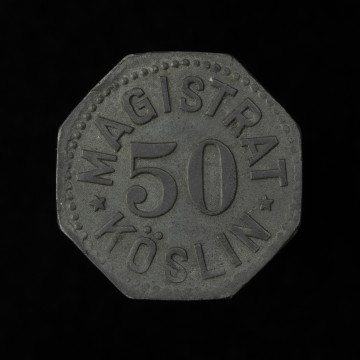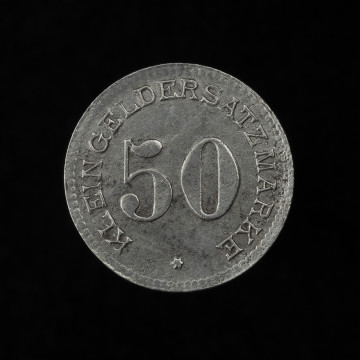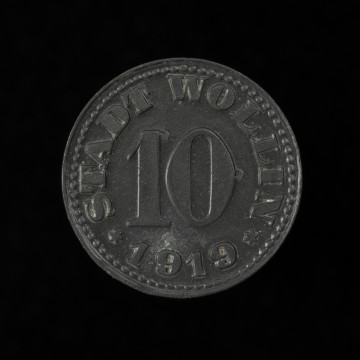
50 pfennig
1901 — 1925
National Museum in Szczecin
Part of the collection: Scrip
In order to facilitate small trade, hampered by the scarcity of small coins on the German money market during World War I, the local administrative authorities took the initiative to independently issue coins. The town of Czaplinek also put itself forward as an issuer of replacement means of payment. The town hall decided to issue their coins in iron, as zinc, which was initially commonly used for minting replacement coins, did not work well in circulation on account of its physical and chemical properties, and was also considered a strategic commodity during the war. The denominations issued included 5, 10, and 50 pfennig coins. The highest denomination, rare to come across nowadays, bore an octagonal form with identical stamps on both sides. The lower denominations, stamped separately for obverse and reverse, had a traditional circular shape and a different diameter for each denomination. On the reverse side, they featured information about the nature of the money, i.e. a small replacement medium of exchange (German. Kleingeldresatzmarke), which, however, was not used in the design of the half-mark coin. All issues, like the featured 10 pfennig coin, had the denomination figure on both sides for practical reasons. In addition to the foregoing examples, a very rare variant of the 5 pfennig coin struck on both sides with the obverse stamp, sometimes referred to as a mint error or mint proof, is also known among the Czaplinek replacement money. However, the intentional production of this variety cannot be ruled out, as collectors of replacement coins were keen to see such unusual pieces in their collections and were therefore willing to pay a lot for them. Mieszko Pawłowski
Other names
10 Pfennig, Notgeld
Author / creator
Object type
token coin
Technique
coining
Material
iron
Origin / acquisition method
purchase
Creation time / dating
Creation / finding place
Owner
Muzeum Narodowe w Szczecinie (1945- )
Identification number
Location / status

1901 — 1925
National Museum in Szczecin

1901 — 1925
National Museum in Szczecin

1919
National Museum in Szczecin
DISCOVER this TOPIC
National Museum in Lublin
DISCOVER this PATH
Educational path